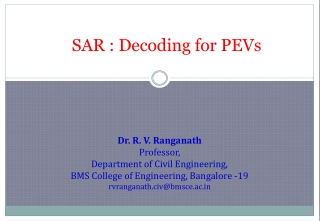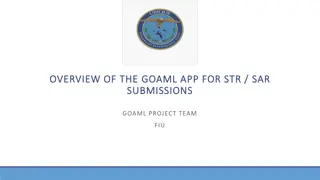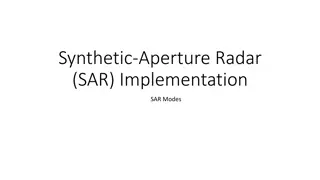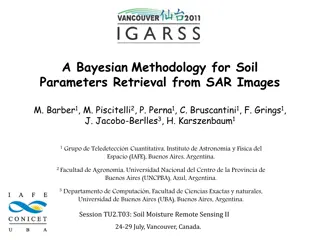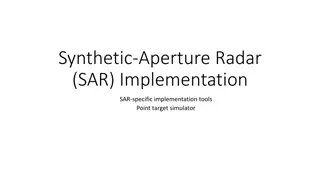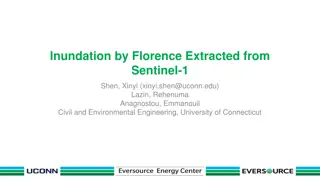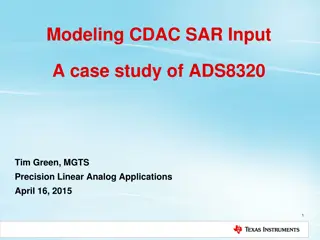
Permanent Scatterers in SAR Images
Explore the significance of Permanent Scatterers in SAR images to mitigate decorrelation issues due to temporal and baseline variations. Learn about techniques for determining Permanent Scatterers and their role in improving DEM accuracy in InSAR applications.
Download Presentation

Please find below an Image/Link to download the presentation.
The content on the website is provided AS IS for your information and personal use only. It may not be sold, licensed, or shared on other websites without obtaining consent from the author. If you encounter any issues during the download, it is possible that the publisher has removed the file from their server.
You are allowed to download the files provided on this website for personal or commercial use, subject to the condition that they are used lawfully. All files are the property of their respective owners.
The content on the website is provided AS IS for your information and personal use only. It may not be sold, licensed, or shared on other websites without obtaining consent from the author.
E N D
Presentation Transcript
The Use of Permanent Scatterers in SAR Images Matthew Heintzelman EECS 826 InSAR Investigation Project 1
Decorrelation: A common issue in multi-pass InSAR is decorrelation between SAR images. This can occur due to: temporal decorrelation: long-term non-stationarity of scatterers. (vegetation growth, soil moisture, freezing/thawing, etc) Baseline decorrelation: differences in the scene due to baseline between observations Atmospheric Phase Screening: decorrelation due to atmospheric variations between observations The above effects mean that the speckle will be different between images (approximately Gaussian [1]), decreasing the correlation obtained during coregistration 2
Decorrelation: Plots present simulated correlation between SAR images as a function of RMS motion (temporal decorrelation), baseline, and rotation [1] and [2] Here, correlation is normalized to [0,1] 3
Permanent Scatterers: Sometimes, circumstances necessitate the use of large spatial or temporal baselines The work in [3] describes a technique for determining and utilizing Permanent Scatterers to estimate Atmospheric Phase Screen and improve DEM Permanent Scatterer: A scatterer (typically within a single pixel), whose returns have a high level of correlation between observations. PS pixels provide an accurate means to estimate baseline induced phase changes, as well as atmospheric effects. PS pixels can also be used to provide accurate DEM estimates in areas with high temporal or baseline decorrelation 4
PS Determination: Must first determine sufficiently persistent scatterers as PS candidates. Intuitive technique is correlation thresholding. This involves choosing PSs that maintain a specified level of correlation over all observations (relative to some master image ) Correlation thresholding becomes a non-trivial optimization problem. Constraints/cost functions are probability of detection and false alarm, where the independent variables are the threshold and correlation tile size PS pixels should have high probability of detection, requiring large tiles for correlation which increase the probability of false alarm. The threshold poses a similar trade-off 5
PS Determination: As an alternative to analyzing coherent data for PS pixels, [3] proposes the use of amplitude only values. Amplitude values are much less sensitive to atmospheric effects and DEM errors, making them stable with respect to changes in baseline or scatterer motion. Tradeoff is that reliable PS determination based on amplitude-only pixels requires many more SAR images (tens instead of a few) Here the ERS data set from the European Space Agency is exploited to provide an adequate number of snapshots. 6
PS Determination The amplitude only pixels are thresholded according to their dispersion index Dispersion index is the ratio of the standard deviation to the average, for high-SNR (good PS candidates) Lower dispersion index means a more stable pixel Dispersion index increases with noise deviation 7
PS Determination: [4] develops an adaptive filter which is used to reduce the sidelobes of PS candidates which dominate surrounding pixels in SAR interferograms. PS candidates are selected using dispersion index thresholding SVA filter is based on a 2-d raised Cosine function where a simplified version of the filter output is: ? ?,? = ? ?,? + ? ? ? 1,? + ?(? + 1,?) + ? ? ?,? 1 + ?(?,? + 1) At each PS pixel, the goal is to choose a and b that minimize the energy of y(n,m). This attempts to resolve the PS to a single pixel 8
PS Determination: After SVA filtering, PS pixels are chosen that retain high-reflectivity at the filter output As a tradeoff, SVA filtering is more complex to perform, but it can reduce the amount of SAR images needed to determine PS pixels SVA filtering typically provides a stricter criterion for for PS selection, compared to disperion index thresholding 9
Using PS Pixels: Once a set of PS pixels are chosen, they must be steered relative to the phase of a pre-determined Master image (as if they were collected with zero baseline). Next, the topographic phase component is corrected for using DEM and satellite position information. The remaining data can be used to solve for line-of-sight velocity ?, DEM error ?, and atmospheric effects ?? and ??. This involves solving a system of nonlinear equations, due to wrapped zero- baseline-steered phase observations . = ???+ ????+ ????+ ? ??+ ???+ ? 10
Using PS Pixels: The preceding equation is solved iteratively until the estimates for ? and ? (DEM error) converge to some tolerance Nonlinearity can hinder convergence In practice, convergence is helped by: Reference DEM should be accurate APS should be dominated by linear phase ramp Scene motion should be slow and constant Data gaps (spatial or temporal) should be avoided (not possible for repeat-pass InSAR) 11
Using PS Pixels: The next step is to estimate Atmospheric Phase Screen (APS) APS is the phase contribution due to the Atmosphere, relative to the phase of the master image. APS components tend to be strongly correlated over short baselines. Due to this, APS estimation is done via kriging, which interpolates and acts as a spatial LPF. Note: exploitation of PS pixels for interferograms only improves the phase estimates for the PS location, not the remaining pixels. The coherent PS pixels can finally be used to fit a DEM estimate. 12
Results: Dataset used was from a 1996 ERS2 collection over Ancona, Italy. 34 SAR images were used to form 33 differential interferograms. This region is unstable and experiences terrain motion causing high temporal decorrelation. Differential Interferogram over Ancona, Italy. 13
Results: (a) Thresholded dispersion index (non-white pixels are persistent scatterers) according to a threshold of 0.25 (b) Estimated APS component (a) (b) 14
Results: Progressively zoomed depiction of SVA detected PS pixels [4]. (a) SVA detected PS pixels. (b) PS pixels found using Dispersion index thresholding. (c) zoomed in view of PS pixels according to dispersion index, but not SVA output. (a) (c) (b) 15
Results: The persistent scatterers were also used to optimize a DEM (a) DEM formed from original data set. (b) DEM optimized on PS pixels Here, improved DEM is further used to provide sub-meter accuracy of PS pixel location. (a) (b) 16
Sources: [1] H. A. Zebker and J. Villasenor, "Decorrelation in interferometric radar echoes," in IEEE Transactions on Geoscience and Remote Sensing, vol. 30, no. 5, pp. 950-959, Sept. 1992, doi: 10.1109/36.175330. [2] University of Kansas. (2021) InSAR Basics [Online] Available: https://people.eecs.ku.edu/~callen58/826/EECS826.htm [3] A. Ferretti, C. Prati and F. Rocca, "Permanent scatterers in SAR interferometry," IEEE 1999 International Geoscience and Remote Sensing Symposium. IGARSS'99 (Cat. No.99CH36293), Hamburg, Germany, 1999, pp. 1528-1530 vol.3, doi: 10.1109/IGARSS.1999.772008. [4] F. Chaabane, M. Sellami, J. Nicolas and F. Tupin, "InSAR permanent scatterers selection using SAR SVA filtering," 2009 IEEE International Geoscience and Remote Sensing Symposium, Cape Town, South Africa, 2009, pp. V-13-V-16, doi: 10.1109/IGARSS.2009.5417746. 17



